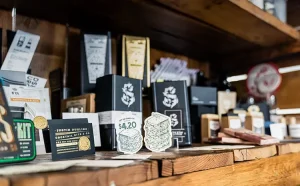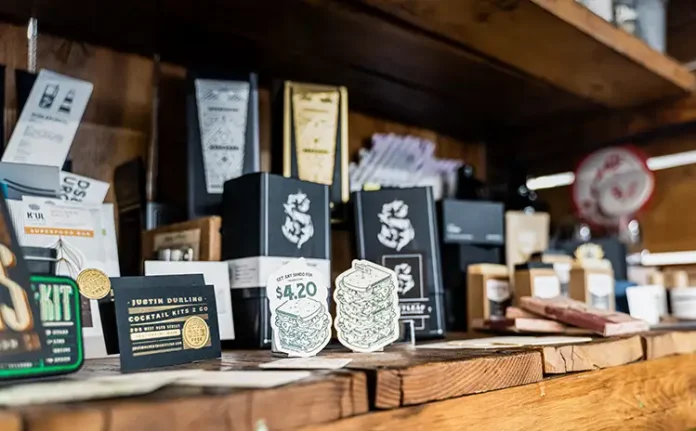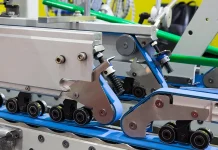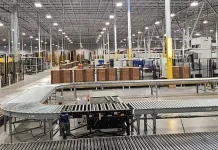By Hallie Forcinio, writer, PostPress
When the pandemic curtailed in-person events and meetings, marketing tactics shifted to include greater use of digital communications such as social media, e-newsletters and websites. With face-to-face meetings returning, these tactics remain essential components of marketing programs, along with focused messaging, new products and product samples.
The pandemic also forced companies to be more proactive. Sam Michaels, creative manager at Studio On Fire, a supplier of impression-based printing, including letterpress, foil stamping and embossing, recalled, “Working with existing customers during COVID-19 became an exercise in communication about safety protocols and supply chains. Things that had never been worries previously had to be planned for: Our conversations had to start much sooner for re-orders. Pivots had to be made as material availability waned. We tried to really amp up our transparency and alert our clients about the roadblocks we were facing.”
More digital communications
Without in-person events such as sales calls, conferences, tradeshows and shop tours, service providers increased emphasis on digital communications. “The restrictions of the pandemic pushed us further onto the internet than ever before: Google Meets, TikTok, email newsletters, etc.,” Michaels said.
LinkedIn has become a favorite social media outlet for Phillips Graphic Finishing, a trade binder and finisher, which serves printers in eastern Pennsylvania and parts of New Jersey and Maryland. “We post in-house-created content as well as links to interesting developments in the industry,” said Andrew Hoffman, president and CEO at Phillips Graphic Finishing.
The company also publishes an e-newsletter called “Finishing Touch.” After emailing monthly for the past two years, it’s currently on hiatus before it shifts to a quarterly schedule in 2023. Each issue includes four links to outside content plus one article written in-house, which also is posted on the company’s website.

Studio On Fire focuses its e-newsletter content on events it is hosting/attending, interesting projects and educational articles about in-house capabilities. Newsletter and social media content is created in-house with everyone participating to identify interesting examples to film, photograph and write about. Michaels said, “We post social media content a few times a week. People love videos of machines. TikTok especially loves the paper cutter.” Although the company does some cross-posting, it avoids posting the same item on all channels so readers don’t find the posts annoyingly repetitious.
Digital Marketing Services, Inc. (DMS Color), a digital printer that supplies collateral materials, packaging, promotional items and other printed products, takes a more personal approach. Its in-house-generated e-newsletter typically posts every 60 days and announces employee work anniversaries, birthdays and employee of the month as well as content about products being produced and common obstacles. “It’s always good to humanize the company,” said Matthew Greer, CEO/CTO at DMS Color.
At DataGraphic, a supplier of printing and printing-related services including offset lithography, digital printing, letterpress, screen printing, custom book printing and bookbinding, bi-weekly e-blasts with professional photography showcase noteworthy projects. “We want to stand out from the crowd whenever we can,” said Glenn Schuster, president of DataGraphic. “As a result, we tend to get some difficult projects that other printers would turn down.”
An enhanced website features new landing pages, new content, hyperlinks and better calls for action. DataGraphic also has beefed up its social media presence by tagging posts and is working to improve search engine optimization (SEO).
New products/services
Although the pandemic brought disruption, it also proved to be a good time to introduce new products/services. Studio On Fire launched Craft Lock Box certified child-resistant, all-paper packaging for cannabis applications. Michaels said, “Marketing a product vs. a service is a new endeavor altogether. Marketing to a cannabis client means you might be talking to a farmer, not a designer. It’s a higher level of client education, but we actually enjoy that.”
DMS Color pivoted during the pandemic to produce personal protective equipment and also launched a new division, Gold Leaf Packaging, to serve the cannabis industry. “Having a separate division helps focus the message and generate demand,” Greer said. “We had to make sure our SEO was right and that we were guiding people and having the right conversations. We really doubled down on our marketing efforts and positioned ourselves as thought leaders and content matter experts.”
Traditional marketing continues
Traditional tactics, word-of-mouth and cold calling remain important marketing tools. Michaels said word-of-mouth is “our most successful way to grow. Our team spends a lot of time working directly with clients, developing their projects, creating dielines, optimizing art, tracking down the perfect materials (and, of course, providing the highest level of printing); it’s a level of service that is easy to recommend to others. We also have developed a level of expertise in several consumer niches, especially packaging within the cannabis market. Having folks on our team who understand the restrictions/guidelines to be aware of as additional states legalize, that’s not something every printer has.”

At DataGraphic, although it receives many referrals via word-of-mouth recommendations, the company also takes a direct approach and reaches out to clients via phone and email.
With the launch of its Gold Leaf Packaging division and face-to-face interaction curtailed by the pandemic, DMS Color focused on cold calling and identifying what vehicles (phone, email, Zoom meetings, etc.) worked best. Although cold calling is essential, Greer noted, “It can be hard to reach the right person.” As a result, whenever possible, he favors events. “Events bring decision-makers and executives into one place,” he explained.
Importance of samples
Studio On Fire maintains an inventory of samples of client projects as well as in-house promotional samples created to show the company’s capabilities. Michaels noted, “One thing remains true, getting to touch/feel the printing still helps, thus we mail out more sample boxes than ever before. The printing we do sells itself when you can feel it.” Seeing and touching samples sparks ideas and helps prospective customers understand processes that they may not have worked with before. Samples can eliminate the need for prototypes and save the time and money associated with prototype tooling and press setup.
Seeing and feeling the quality of the work is key. “Samples can bring clients over the finish line by providing a better understanding of what they are ordering and confirming that print can do what they are trying to do,” explained Nicole Cappiello, a member of the sales and business development team at DataGraphic. Samples also reveal the clients a company serves and “lend credibility,” added Schuster.
At Phillips Graphic Finishing, a box of samples goes on sales calls. The company also relies on its website to present examples of its work.
Gauging success
Key performance indicators (KPIs), dashboards and other analytics help track marketing efforts. Phillips Graphic Finishing tracks KPIs and identifies customers gained via marketing efforts. It also compares revenue from resulting projects vs. revenue from existing customers.
DataGraphic studies analytics to see what information customers are looking for and find interesting. “We have our own customer relationship management (CRM) program and know who responds,” explained Schuster.
“We also are taking a closer look at how customers find us,” Cappiello said.
“Google Ad Words, Instagram, assorted social media efforts all have dashboards, but they don’t always tell you what you need to know,” Michaels said, adding, “In the end, we can tell if we’re succeeding by what jobs hit the production floor. When we market our capabilities well, you can hear it: The machines are running, and the shop is abuzz with activity.”
Greer looks upstream to the pipeline to gauge success. “The level of business coming in is the leading indicator of what’s to come,” he said. To closely monitor the sales process, DSM Color uses CRM software and recently hired a vice president of Sales and Marketing.
Looking forward
Like every year, 2023 will bring challenges and opportunities. Challenges relate primarily to turnaround time, supply chain issues and rising costs, particularly for paper. “We used to buy paper a la carte for each project,” Schuster said. “Now, we are stocking up when we can so we have stock on hand. Where customers used to be dead set on a brand and type of paper, they now definitely need to look at alternatives.”
Another huge challenge is teaching customers how to set up and work with files for embellishment processes. “A good design workflow and prepress workflow are essential,” Greer said. But, a lot of designers are not familiar with what is needed and not all design programs provide sufficient support.
Opportunities rely largely on diversification and communication. “The world changes so quickly, we’ve learned not to put too many eggs in one basket,” Michaels said. Cappiello agreed, noting DataGraphic is looking beyond current customers to new markets as well as for new customers in existing markets.
DMS Color is taking a similar tack and expanding its web-to-print process shop site by developing a web interface for packaging. The web-to-pack site will present 100 different packaging options for the cannabis/CBD markets. To complement its digital foil equipment, it also has installed a traditional machine for higher volume jobs.
To foster communication, Phillips Graphic Finishing plans to do more email marketing in 2023. Hoffman explained, “The more you communicate with customers, the more they understand your capabilities. People get distracted and forget. Using LinkedIn and the e-newsletter to promote name recognition and keep our capabilities fresh in people’s minds helps attract business.”





